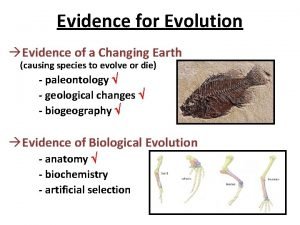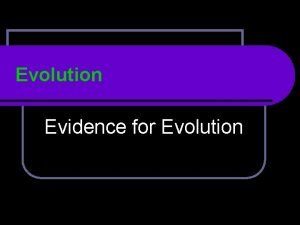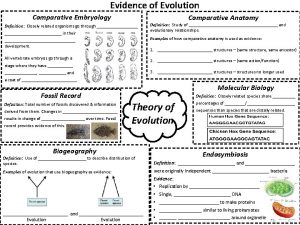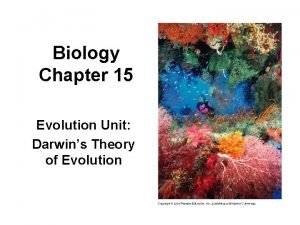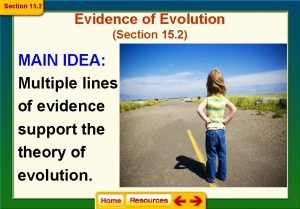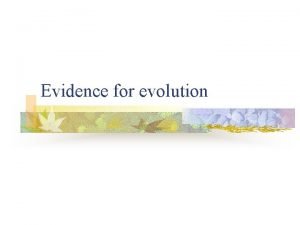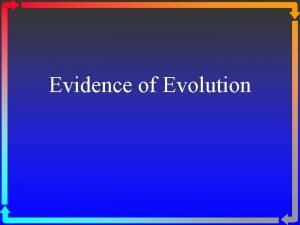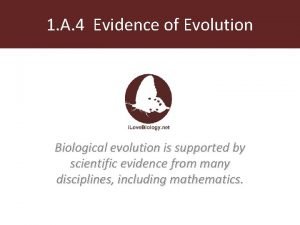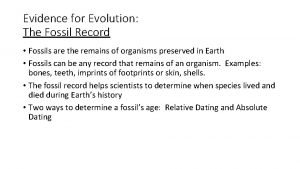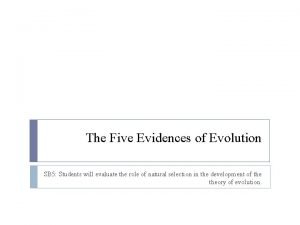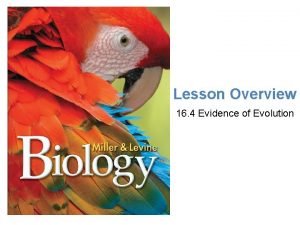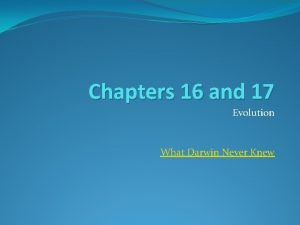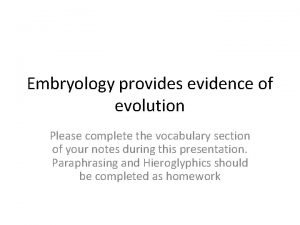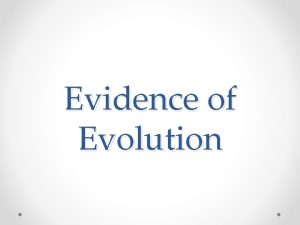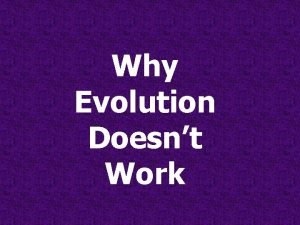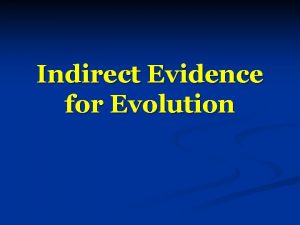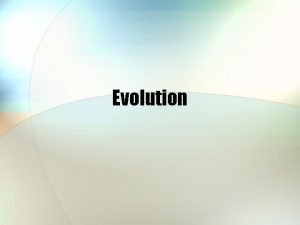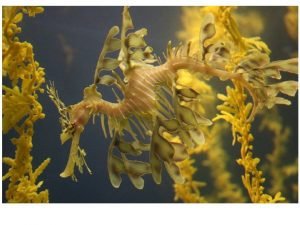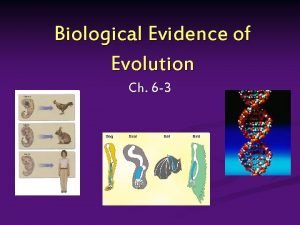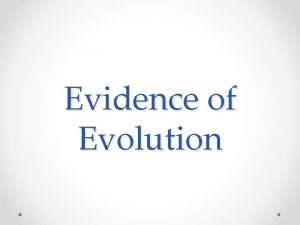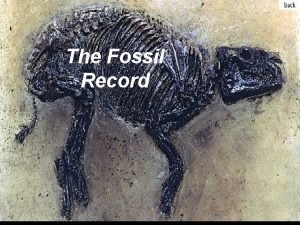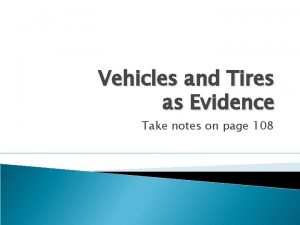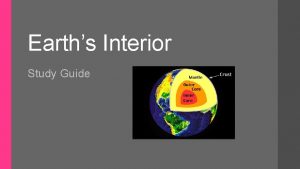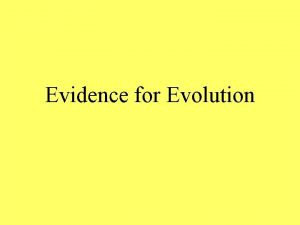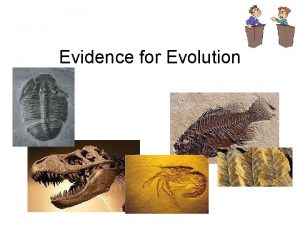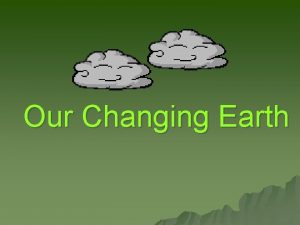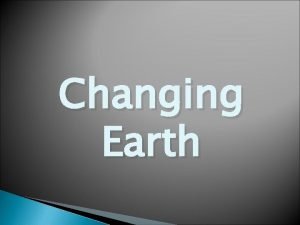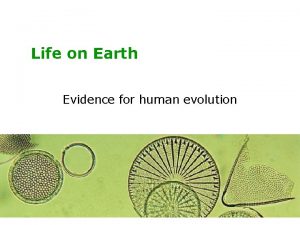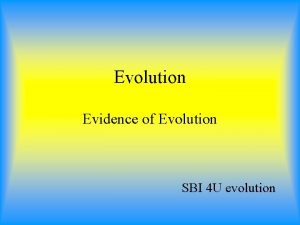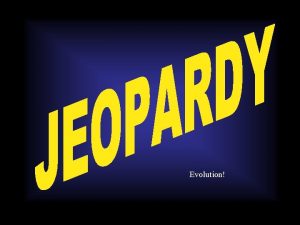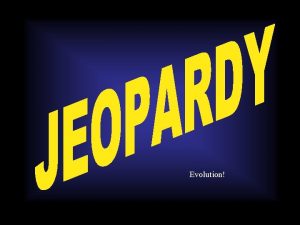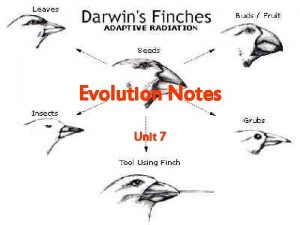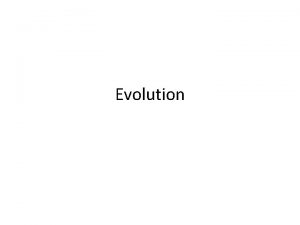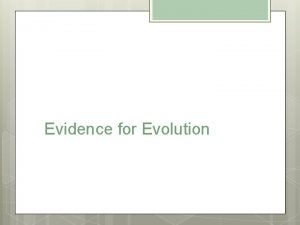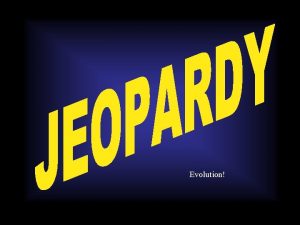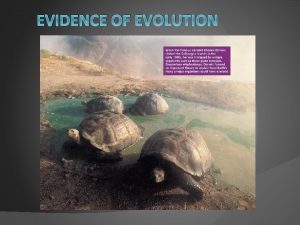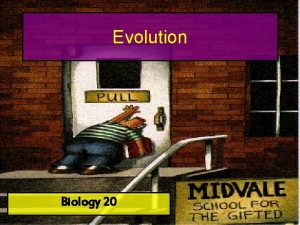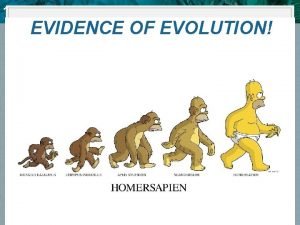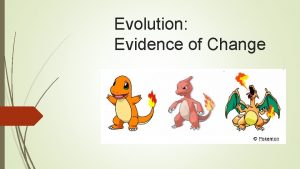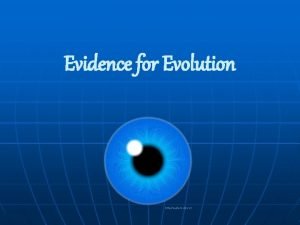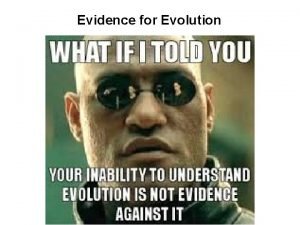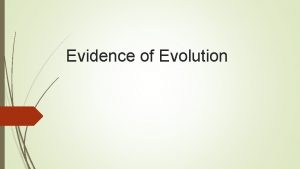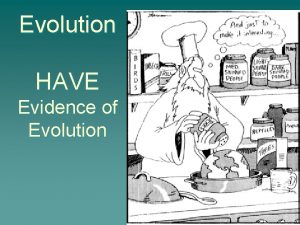Evidence for Evolution Evidence of a Changing Earth








































- Slides: 40

Evidence for Evolution àEvidence of a Changing Earth (causing species to evolve or die) - paleontology - geological changes - biogeography àEvidence of Biological Evolution - anatomy - biochemistry - artificial selection

Biochemical Evidence for Evolution

Biochemical Evidence for Evolution DNA = hereditary material that determines which characteristics are passed on = composed of 4 nucleotide bases (adenine, thymine, cytosine, % guanine) = a grouping of 3 consecutive bases is called an amino acid

Biochemical Evidence for Evolution DNA = hereditary material that determines which characteristics are passed on = composed of 4 nucleotide bases - adenine (A) - thymine (T) - cytosine (C) - guanine (G) A T G C

Biochemical Evidence for Evolution DNA = hereditary material that determines which characteristics are passed on = composed of 4 nucleotide bases (adenine, thymine, cytosine, & guanine) = a grouping of 3 consecutive bases is a code for a specific an amino acid molecule

Biochemical Evidence for Evolution DNA = hereditary material that determines which characteristics are passed on = composed of 4 nucleotide bases (adenine, thymine, cytosine, & guanine) = a grouping of 3 consecutive bases is a code for a specific an amino acid molecule Example: AGT codes for the Serine amino acid A G T

Biochemical Evidence for Evolution Chains of Amino Acids make Proteins = molecules that make up organismal structures, including muscle and skin cells

Biochemical Evidence for Evolution Studying Proteins = Over time, similar proteins in different species become increasingly different… suggesting the molecules are undergoing an evolution Example: Amino acid sequence differences among Hemoglobin molecules

Biochemical Evidence for Evolution Example: Amino acid sequence differences among Hemoglobin molecules Human Macaque Dog Bird Frog Lamprey Time 1 25 50 75 100 125 Number of Amino Acid Differences between Hemoglobin Molecules

Evidence from Artificial Selection Since agriculture first started, people have been artificially selecting crops and livestock to alter their appearance, behaviour and chemical composition - simulates how Natural Selection works (but much faster)

Evidence from Artificial Selection Trait being selected for: Worst Best Individuals (within the plant or animal population)that have the desired trait are selected and bred. The best offspring are then picked to breed again

Evidence from Artificial Selection Sea Cabbage Example: Different characteristics of the sea cabbage have been selected for, resulting in different varieties of the same plant species

Theories of Evolution LAMARCKIAN DARWINIAN VS. EVOLUTION

LAMARCKIAN EVOLUTION In the early 1800 s, Jean-Baptiste Pierre Antoine de Monet Chavalier de Lamarck proposed the idea of SPONTANEOUS GENERATION àsuggests that living things arose from non-living matter and gradually became more complex àorganisms are able to produce new parts to satisfy there need to adapt to their environment

LAMARCKIAN EVOLUTION Example: If a giraffe needs to reach higher food, continual stretching will result in the slight elongation of the neck. And this new trait can be passed to the next generation, and so on.

LAMARCKIAN EVOLUTION Example: If a giraffe needs to reach higher food, continual stretching will result in the slight elongation of the neck. And this new trait can be passed to the next generation, and so on. . . so the acquired trait can be inherited!!

LAMARCKIAN EVOLUTION Lamarck’s theory is now referred to as “The Inheritance of Acquired Characteristics”

LAMARCKIAN EVOLUTION Lamarck’s theory is now referred to as “The Inheritance of Acquired Characteristics” X and has been completely dismissed as a wrong!

LAMARCKIAN EVOLUTION Lamarck’s theory is now referred to as “The Inheritance of Acquired Characteristics” X and has been completely dismissed as a wrong! … Acquired traits cannot be inherited

DARWINIAN EVOLUTION In 1831, Charles Darwin travelled the world on the HMS Beagle. What he saw of the natural world, left him with many questions…

DARWINIAN EVOLUTION Observations and Predictions 1) Sloths and Armadillos living in SA resembled the smaller fossils found in the same area 1) The larger, living forms of Sloth and Armadillo might have descended from these fossils 2) The African tropics and South American tropics had very few organisms in common 2) Each continent acted like an isolated nursery with species evolving 3) The Galapagos Islands were home to 13 different species of finches 3) All 13 species evolved from a single ancestor on the island

DARWINIAN EVOLUTION Observations and Predictions 1) Sloths and Armadillos living in SA resembled the smaller fossils found in the same area 1) The larger, living forms of Sloth and Armadillo might have descended from these fossils 2) The African tropics and South American tropics had very few organisms in common 2) Each continent acted like an isolated nursery with species evolving 3) The Galapagos Islands were home to 13 different species of finches 3) All 13 species evolved from a single ancestor on the island

DARWINIAN EVOLUTION Observations and Predictions 1) Sloths and Armadillos living in SA resembled the smaller fossils found in the same area 1) The larger, living forms of Sloth and Armadillo might have descended from these fossils 2) The African tropics and South American tropics had very few organisms in common 2) Each continent acted like an isolated nursery with species evolving 3) The Galapagos Islands were home to 13 different species of finches 3) All 13 species evolved from a single ancestor on the island

DARWINIAN EVOLUTION Darwin’s Finches from one species, many evolved to take advantage of different food

DARWINIAN EVOLUTION Darwin’s Theory of Natural Selection The process whereby organisms better adapted to their environment tend to survive and produce more offspring

DARWINIAN EVOLUTION Summary à Individuals of the same species are in constant struggle for survival à Individuals with more favourable traits are more likely to survive and pass on their genetic information. This is natural selection! à These individuals contribute more offspring to succeeding generations and therefore their favourable traits will become more common. This is Evolution!

DARWINIAN EVOLUTION BACK TO THE GIRAFFES!

INHERITED VARIATION What does this mean? “Inherited” refers to traits being passed down genetically from parent to offspring In order for natural selection to occur, there needs to be variation among traits in the population… where does this variation come from?

INHERITED VARIATION Variation in species comes from two biological processes: Mutations & Sexual Reproduction

à DNA is found in the Chromosomes of a nucleus à Chromosomes contain Genes à Genes are sequences of amino acid codes that have an associated trait à DNA consists of millions of genes & can be considered a blueprint for a particular organism à In most cases, DNA stays the same throughout the organisms life

Mutations àRandom changes in the DNA sequence of a chromosome àMay or may not result in a change in the gene’s trait

Mutations àRandom changes in the DNA sequence of a chromosome àMay or may not result in a change in the gene’s trait Before After A A G G G T Example: DNA Segment Before Mutation = ACT AGG CTG DNA Segment After Mutation = ACT AGT CTG

Mutations can be Caused by: àEnvironmental Factors (example: exposure to chemicals or radiation) àErrors when cells are making copies of the DNA

Effects of a Mutation depends on àwhat DNA sequence is altered à how gene expression is impacted

Neutral Mutations: no immediate effect on organism’s fitness (fitness = reproductive success) Harmful Mutations: reduces organism’s fitness Beneficial Mutations: gives organism an advantage over others and increases fitness

Neutral Mutations: no immediate effect on organism’s fitness (fitness = reproductive success) Harmful Mutations: reduces organism’s fitness Beneficial Mutations: gives organism an advantage over others and increases fitness LEAST COMMON IN NATURE

INHERITED VARIATION Variation in species comes from two biological processes: Mutations & Sexual Reproduction

Asexual vs. Sexual Reproduction Asexual = Individuals reproduce without a mate = Offspring receives identical copy of parent’s DNA = Siblings have identical traits (same as parent) = mutations are the only source of inherited variability, therefore little opportunity for natural selection to take place Asexual Reproduction of Bacteria

Asexual vs. Sexual Reproduction Sexual = The production of offspring by the union of sex cells from two different parents = Offspring inherit a combination of genes from both parents = Results in a great amount of variability…

Asexual vs. Sexual Reproduction 3 Reasons for this Great Variability 1) Each parent has 2 copies of every gene (may or may not be the same) and give one copy to the offspring… leading to many possible combinations! 2) The gene copies are passed down randomly 3) Sexually reproducing organisms choose different mates with different genetic a make-up… leading to even more potential combinations of genes!
 Biochemical evidence examples
Biochemical evidence examples Developmental homologies
Developmental homologies What is evolution
What is evolution Definition of comparative embryology
Definition of comparative embryology Molecular biology evidence of evolution
Molecular biology evidence of evolution Section 15-2 evidence of evolution answer key
Section 15-2 evidence of evolution answer key Embryology evidence of evolution
Embryology evidence of evolution What are the 4 types of evidence for evolution
What are the 4 types of evidence for evolution Scientific evidence
Scientific evidence What does amber
What does amber What are the 5 evidences of evolution
What are the 5 evidences of evolution Animal embryos
Animal embryos Charles darwin
Charles darwin Example of evolution
Example of evolution 4 types of evidence for evolution
4 types of evidence for evolution Evidence of evolution
Evidence of evolution Indirect evidence of evolution
Indirect evidence of evolution Evidence of evolution stations
Evidence of evolution stations Embryological evidence of evolution
Embryological evidence of evolution Molecular biology evidence of evolution
Molecular biology evidence of evolution 6 evidences of evolution
6 evidences of evolution 4 types of evidence
4 types of evidence Evidence of evolution of remnants and impressions *
Evidence of evolution of remnants and impressions * Evidence for evolution doodle notes
Evidence for evolution doodle notes How do geologists study direct evidence of earth's interior
How do geologists study direct evidence of earth's interior Vanlig celldelning
Vanlig celldelning Programskede byggprocessen
Programskede byggprocessen Karttecken
Karttecken Rbk mätning
Rbk mätning Tryck formel
Tryck formel Elektronik för barn
Elektronik för barn Kung som dog 1611
Kung som dog 1611 Vad är densitet
Vad är densitet Tack för att ni har lyssnat
Tack för att ni har lyssnat Smärtskolan kunskap för livet
Smärtskolan kunskap för livet Frgar
Frgar Epiteltyper
Epiteltyper Större och mindre tecken
Större och mindre tecken Magnetsjukhus
Magnetsjukhus Ekologiskt fotavtryck
Ekologiskt fotavtryck Särskild löneskatt för pensionskostnader
Särskild löneskatt för pensionskostnader
